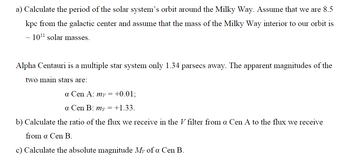Question

Transcribed Image Text:a) Calculate the period of the solar system's orbit around the Milky Way. Assume that we are 8.5
kpc from the galactic center and assume that the mass of the Milky Way interior to our orbit is
~ 10¹¹ solar masses.
Alpha Centauri is a multiple star system only 1.34 parsecs away. The apparent magnitudes of the
two main stars are:
a Cen A: my = +0.01;
a Cen B: my = +1.33.
b) Calculate the ratio of the flux we receive in the V filter from a Cen A to the flux we receive
from a Cen B.
c) Calculate the absolute magnitude My of a Cen B.
Expert Solution
This question has been solved!
Explore an expertly crafted, step-by-step solution for a thorough understanding of key concepts.
Step by stepSolved in 2 steps with 2 images

Knowledge Booster
Similar questions
- A distant F0 star is 6.3 times less bright than a nearer F0 star which has a parallax of 0.2 arcsec. Calculate its distance in parsecs.arrow_forwardYou've just discovered a new X-ray binary, which we will call Hyp-X1 ("Hyp" for hypothetical). The system Hyp-X1 contains a bright, 82 main- sequence star orbiting an unseen companion. The separation of the stars is estimated to be 23 million kilometers, and the orbital period of the visible star is 4 days Part C Determine the mass of the unseen companion.(Hint A main-sequence star with spectral type B2 has a mass of about 10M) Express your answer as a multiple of Sun's mass to two significant figures. Musso Submit Part D Request Answer | ΑΣΦ Is it a neutron star or a black hole? black hole neutron star ? Munarrow_forward1:Which star has been redshifted the most? 2:Which star is moving towards us the fastest? Star C Star D Star A Star B 3:The wavelength of this spectral feature is measured to be 600nm in the lab, and 609 in Star A. What is the radial velocity of Star A? using km/s,arrow_forward
- Looking for ___Mpcarrow_forward1.) How far, in parsecs, is an object that has a parallax of 1 arc second? How far is it, in light years? 2.) How far in parsecs, is an object that has a parallax of 0.1 arc-seconds? How far is it, in light years?arrow_forwardThis star has a mass of 3.3 MSun. What is the main sequence lifetime of this star? You may assume that the lifetime of the sun is 1010 yr.arrow_forward
- The center of our Galaxy is about 7500 parsecs from Earth. What would be the parallax angle of a star near the center of the Galaxy? Could this angle be measured with current technology?arrow_forwardA Type Ia supernova is observed and achieves an apparent magnitude of m = 19.89 at peak brightness. The absolute magnitudes of Type Ia supernovae at peak brightness are known to be M=−19. Determine the distance to the supernovae in units of Mpc.arrow_forwardIf an X-ray binary consists of a 10-solar-mass star and a neutron star orbiting each other every 20.8 days, what is their average separation? (Hints: Use the version of Kepler's third law for binary stars, M, + M3 = ; make sure you express quantities in units of AU, solar masses, and years. Assume the mass of the neutron star is 1.6 solar masses.) a3 AUarrow_forward
- using the center-of-mass equations or the Carter of Mass Calculator (under Binary-Star Basics, abova), you will investigate a specific binary star system. Assume that Star 1 has m, 3.2 solar masses, Star 2 has m,-0.9 solar masses, and the total separation of the two (R) is 34 All (One AU is Earth's average distance from the Sun) (2) What is the distance, d. (In Au) from Star 1 to the center of mass? AU (b) What is the distance, dy On Au) from Star 2 to the center of mass AU ( what is the ratio of d, tod?arrow_forwardhelparrow_forwardPlease Asaparrow_forward
arrow_back_ios
SEE MORE QUESTIONS
arrow_forward_ios